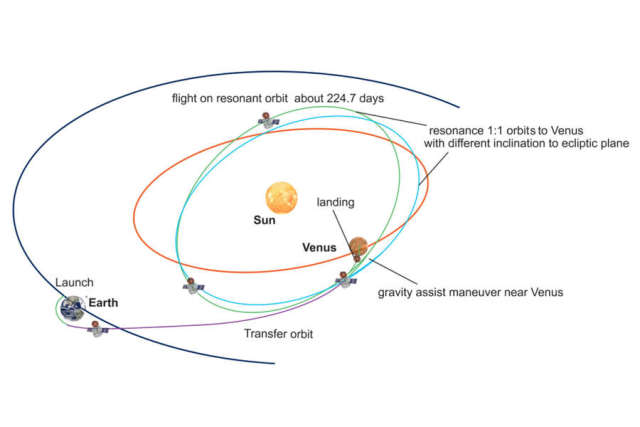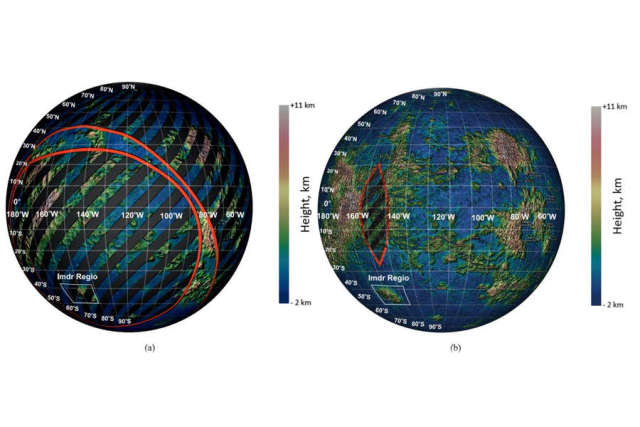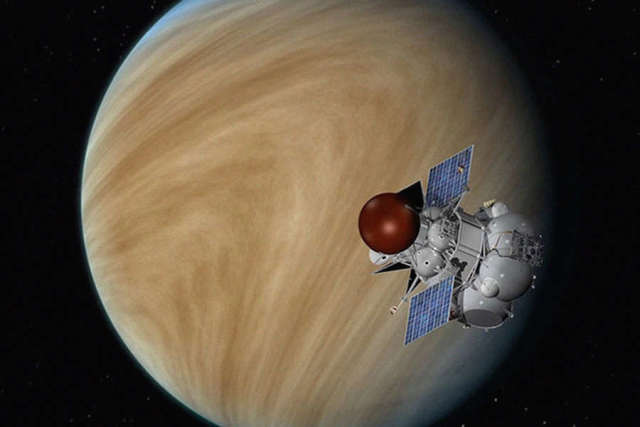Russian scientists decided to land on Venus in a new way
Scientists of the Space Research Institute of the Russian Academy of Sciences proposed using a new landing scheme for the Venus-D project. This is an original idea that will be used in Russian cosmonautics for the first time. One of the project managers and co-author of the article, head of the laboratory of spectroscopy of planetary atmospheres Lyudmila Zasova told the newspaper.Ru", why an extra revolution around the Sun is needed to land on the planet, what devices will be used and what will the Americans' exit from the mission lead to.
In 2029, Roscosmos intends to send the Venera-D automatic station to Venus. It will consist of an orbiter and a landing craft for a comprehensive study of the atmosphere of Venus. In a recent article, scientists of the ICI RAS proposed to perform a special gravitational maneuver when approaching Venus, similar to what was used in the past to change the speed of the Voyager-1,2, Mariner-10, Cassini and others missions from different planets.
- Lyudmila Veniaminovna, tell us what problem the gravitational maneuver for landing on Venus should solve?
- It is assumed that Venus-D will be launched from the Vostochny cosmodrome in 2029. Its trajectory is calculated on a certain date "in the window" of the start. The station is first put into near-Earth orbit, then on a flight path to Venus. During the flight, the necessary corrections are made, and a few days before the station enters orbit around Venus, the lander is separated from it, which flies to Venus according to a pre-calculated trajectory. The flight time to Venus takes about six months (standard algorithm).
Mathematical calculations of this maneuver were performed based on the results of a study by graduate student Vladislav Zubko under the guidance of a leading researcher at the ICI RAS, Nathan Eismont.
- Such maneuvers are often used in interplanetary flights, how will it be performed in your case?
- The gravity maneuver proposed for the Venus-D project aims to expand the zone of possible landing of the device. This original idea will be applied for the first time.
A change in the direction of motion of an apparatus approaching a planet under the influence of its gravitational field can both increase and decrease the speed of the apparatus relative to the Sun, depending on whether it initially moved in the same direction as the planet, or towards it. In our case, the trajectory was calculated so that the device, passing near Venus, reduced its speed relative to the Sun.
Such a maneuver around Venus should change the trajectory of the station's flight, and it will switch to a synchronous, resonant orbit around the Sun with Venus, so that it will fly to Venus for the second time in 224 days, in a Venusian year. In fact, we make one extra revolution around the Sun.
The last launch to Venus with a landing on the surface was made almost 40 years ago, these were the Soviet Vega-1 and -2 stations.

The flight scheme of the mission using a gravity maneuver
Image source: ICI RAS
- So you lose almost a year, but you get the opportunity to expand the area of possible planting. How much do you increase this area?
- We will be able to access almost all of Venus except for a small area. At the same time, we get the opportunity to land in the selected area with greater accuracy.
- Has the decision to use the maneuver been made? Or is it just an option for now?
- Most likely, we will fly with a maneuver, now this option is considered as a priority.
- What areas on Venus are you interested in landing?
- The landing sites have not yet been finally selected. They are chosen from the point of view of scientific significance, on the one hand, and landing safety, on the other. However, we know so little about our nearest neighbor that working on any part of the surface with the help of modern scientific equipment will give a lot of new things. From the point of view of scientific significance, mountainous areas, the so-called tesserae, are the most interesting, but these are also the most dangerous areas for planting.
Previously, when the Venera-Vega stations were launched, almost nothing was known about the relief of Venus, nevertheless, ten Soviet stations (from 1970 to 1985) successfully worked on the surface of Venus. The choice of landing site is so important from the point of view of science that two international meetings on the choice of landing site were held at the ICI RAS, organized by the Joint Scientific Working Group ICI/Roscosmos - NASA (ONRG) on the Venus-D project in 2019 and 2021.
We are interested in Tesserae from the point of view of the planet's past. The surface of Venus has been renewed in the last 700 million years as a result of powerful volcanic eruptions. Most of the surface (80%) was flooded with lava. In mountainous areas that are not flooded with lava, ancient rocks can probably be found. The study of their composition, the presence of minerals formed in the presence of water, may indicate that there may have been an ocean on Venus in the past, in the first billions of years of its existence, in which life could arise, since during the formation Venus received water that was contained in protoplanetary material.
Venus is closer to the Sun than the Earth, the luminosity of the young Sun grew, water evaporated, went into the atmosphere, creating a greenhouse effect, water molecules disintegrated into hydrogen and oxygen atoms and eventually left the planet, and as the temperature rose, carbon dioxide and sulfur compounds were released into the atmosphere, enhancing the greenhouse effect, due to whose surface is heated by 500 degrees.
- Which rocket will the mission fly on?
- It is planned to launch using the Angara-A5 rocket
- You have two launch years in your article: 2029 and 2031. Why?
- There are certain "windows" in time when a flight to Venus can be made with a minimum amount of energy expended, which means that it is possible to increase the payload. Thus, according to the calculations of NPO Lavochkin, when launched in 2029, 4.8 tons can be brought to the departure trajectory to Venus, in 2031 there are already more than five, so both launch dates are being studied.
- Recently, Lavochkin's NGO started designing the station, is there any clarity with funding?
- The project is at the stage of "Technical proposal", or stage "A" according to NASA classification. Money has been allocated for this (paper) stage. The project was well worked out by ONRG. We use the materials of the group's reports. The complex developed by ONRG included an aerostat probe proposed by NASA. Now Lavochkin's NGO is creating an aerostat probe to replace the American one. Soviet balloon probes of the Vega-1 and Vega-2 stations worked in the cloud layer of Venus in 1985. They were the first and still remain the only balloons floating in the atmosphere of Venus. The descent vehicle, inside which both the lander and the balloon are located, enters the atmosphere, then they separate. With the help of parachutes and a landing device, the device lands on the surface, and the balloon probe in the atmosphere is brought to its floating height.
- What kind of devices will be on it?
- This is only being discussed now, but in general terms it is a meteorological complex that measures temperature, pressure, wind. A device for recording aerosol particles should be developed. There will be a laser spectrometer with a high spectral resolution for measuring the concentration of sulfur-containing gases. There will be a gas chromatograph to measure the composition of the atmosphere and clouds at a floating altitude. An experiment is planned to detect lightning. At night, a surface is visible in the spectral region with a wavelength of 1 micrometer, observations will reveal signs of thermal, and maybe volcanic activity.
The balloon will float at an altitude of approximately 55 km. Here the conditions are close to terrestrial, the temperature is from -50 to +50. It is also assumed that he will be able to change the swimming height.

Unreachable areas on Venus at launch in 2029 without maneuver and with maneuver
Image source: ICI RAS
- What instruments will be on the lander?
- Firstly, there will be instruments for measuring the chemical composition of the atmosphere and clouds, they will work on descent and after landing for about two hours. There will be devices measuring the mineralogical composition of the surface, elemental composition, isotopes, including radioactive radiogenic isotopes. Knowing their relative contents is important for understanding the evolution of the surface. Naturally, the illumination of the surface and the aerosol components of the atmosphere will be measured. The TV complex will be switched on.
It is planned to carry out soil sampling, drilling will take place to a depth of several centimeters (previously, a similar experiment was carried out on Soviet apparatuses). This is a very complex process - drilling solid ground at a pressure of 100 atmospheres at a temperature of almost 500 ° C. It is necessary to collect samples after drilling, deliver them inside the hermetic compartment, distribute these samples among several instruments for analysis.
- Which of the planned tasks were not solved on the Soviet "Venus"?
- A number of tasks. I have already mentioned some of them - for example, a much more detailed analysis of the soil. Soviet devices "Venus-9, -10, -13, -14" for the first time received images that made it possible to see a surface permanently covered with a twenty-kilometer layer of clouds without breaks. It is planned to install a television complex on the Venus-D lander, including landing, panoramic and even microscopes. The most modern scientific instruments will be installed on the lander, the capabilities and accuracy of which differ by orders of magnitude from those used on Venus.
- Some time ago, a lot of noise was made by the story of the discovery of phosphine in the atmosphere, allegedly indicating the presence of life. Will the mission study this problem?
- There will be a high-resolution spectrometer on the orbiter that will try to detect phosphine lines. There will also be experiments that will detect phosphorus on the balloon and the lander, the presence of phosphorus was previously found in the middle cloud layer by Soviet landers along with chlorine, nitrogen, carbon, sulfur.
- Let's talk about the Americans' exit from the mission. The letter "D" in the name stood for "long-lived" thanks to the American long-lived LLISSE station on board. It could work on the surface for a long time, since Americans have high-temperature electronics capable of operating at 500 degrees. We do not have such electronics, and therefore the device will be able to live on the surface, like the Soviet "Venus", only for a couple of hours?
- About the letter "D" is not quite true. The mission was previously included in the Federal Space Program (2006-2015) as "Venus-D", where the letter "D" already stood for "long-lived". The mission was to contain a long-lived station designed to operate on the surface for 30 days. In the Soviet Union, after the successful landings of Venus in the 80s, the idea of a long-lived station was developed, but it was not implemented. After the inclusion of the Venera-D project in the 2006-2015 FCP, attempts were made to develop the design of such a station, but it turned out that the complexity of the development and the cost compared to the possible scientific output were not in favor of the latter.
It was concluded that without the use of high-temperature electronics capable of operating in an aggressive environment on the surface of Venus, it is impractical to make a long-lived scientific station. It is known, however, that NASA has high-temperature electronics. As a result of ONRG's work on the Venus-D project in 2016, NASA's Glenn Center began developing the long-lived station that you mention: - LLISSE (Long Lived In-situ Soar System Explorer) for the Venus-D project. In 2020, a model of the station was tested for 60 days at the GEER extreme conditions test facility, in the Glenn Center, in which it is possible to simulate Venusian conditions: temperature, pressure, atmospheric composition.
Of course, we are very sorry that the joint mission with NASA did not work out, the scientific tasks determined as a result of the work of the ONRG will be solved by other means. Note that NASA considered the balloon and long-lived stations as its contribution to the project. Currently, the letter "D" - "long-lived" - can be attributed to the Lavochkin NPO balloon (operating time up to 3 months) and the orbiter (up to 10 years).
At the temperatures and pressures prevailing on the surface of Venus, only some relatively simple devices made on the basis of high-temperature electronics can work for a long time. These are devices (simple, but very important) for measuring temperature, pressure, wind, illumination, chemical composition of the atmosphere near the surface, and seismics.
Sophisticated modern scientific instruments are installed on the lander. They cannot work in an aggressive environment on the surface of Venus, so they are placed in a sealed compartment (such as a Dewar vessel) to isolate them from the high temperature and pressure of the external environment. In two hours of work on the surface, important information will be obtained that will allow us to better understand our nearest neighbor, which is still terra incognita for us.
- Is the electronic component base that is planned to be used domestic?
- I'm not an expert. Previously, there was a calculation for the use of individual imported elements. This could be a problem right now.
- Can China deliver its devices at a certain stage?
- It's hard to say yet. No concrete proposals have been received so far.
- Is the idea of returning soil from Venus being worked out on subsequent missions?
- Lavochkin's NGO is working on this topic, because such a task was really set by the leadership of Roscosmos. It is in the long-term plans, and not only in Russia, but also in other agencies. To do this, it is supposed to use a system of balloons, which gradually lifts the capsule with samples from the surface, followed by its interception by a spacecraft. But so far, this task is still far away. When it will be possible - it is difficult to say now, even according to the most optimistic forecasts, not before the mid-30s.
Pavel Kotlyar

